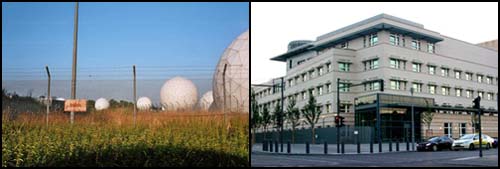Recent revelations in the German press demonstrate that the National Security Agency (NSA) continues to evade the U.S. Foreign Intelligence Surveillance Act (FISA) and the Fourth Amendment of the U.S. Constitution by using its second and third party signals intelligence (SIGINT) partners to carry out surveillance on U.S. persons.
The German Federal Intelligence Service (BND) used systems provided to it by NSA, including XKEYSCORE, to track certain “selectors”—telephone numbers, email addresses, website URLs, and IP numbers—to zero in on the communications of employees at the U.S. embassy in Berlin. Ironically, the U.S. embassy also houses an NSA unit dedicated to monitoring the communications of top German government officials, including Chancellor Angela Merkel and top officials of the BND.
For decades, the NSA and its partners have worked around domestic laws regulating surveillance without legal authority by tasking their foreign partners to carry out the surveillance. Currently, BND surveillance is largely conducted from the former NSA base at Bad Aibling in Bavaria. The base is under BND control and was modernized by NSA under a 2002 agreement between NSA and the BND. A small contingent of NSA personnel currently provides maintenance and other support. The NSA personnel at Bad Aibling would have been aware of the use of XKEYSCORE and other systems to spy on U.S. diplomatic, military, and intelligence personnel attached to the U.S. embassy in Berlin.

NSA's former base at Bad Aibling, with its small NSA contingent, left, used to spy on U.S. embassy in Berlin and its larger NSA contingent, right. What's the overall purpose of this intelligence nonsense?
NSA’s espionage against Central Intelligence Agency personnel in Berlin and elsewhere may have ultimately resulted in Edward Snowden’s successful operation to expose the extent of NSA surveillance. Before working as an NSA contractor, Snowden was employed by the CIA. Initially, Snowden, who worked for Booz Allen, was reported to have been assisted by two others at the NSA center in Kunia, Hawaii—one military officer and a civilian government employee. Little has been reported on these two individuals since Snowden’s successful escape to Moscow via Hong Kong. WMR learned that at least one of the two accomplices may have been acting under highly-compartmented orders from CIA to assist Snowden in the downloading of the NSA data and his exfiltration to Hong Kong.
The NSA and its partners have long denied that they rely on one another to conduct surveillance that would be illegal if they carried it out within their own countries. Thanks to the revelations of Canada’s version of Edward Snowden, retired Communications Security Establishment (CSE) [now Communications Security Establishment Canada or CSEC] technician Mike Frost, it is known that in the 1980s, CSE was used by British Prime Minister Margaret Thatcher and Britain’s Government Communications Headquarters (GCHQ) to spy on two of Thatcher’s own Cabinet ministers who were not to be thought “on side” with the prime minister’s political objectives prior to the 1983 general election. By using CSE personnel to spy on the British ministers, Thatcher and GCHQ could claim plausible deniability. Ironically, one of the ministers spied upon and then fired by Thatcher after her resounding re-election was Foreign Secretary Francis Pym, a Conservative Party moderate who was in charge of GCHQ and the MI6 Secret Intelligence Service. The other was Deputy Prime Minister and Home Secretary William Whitelaw who was moved to be Speaker of the House of Lords, an insignificant position.
CSE also eavesdropped the car phone of the U.S. ambassador in Ottawa with NSA liaison officers fully aware of the espionage. In the 1960s, when French President Charles de Gaulle made common cause with the independence movement of French-speaking Quebec, CSE had the Norwegian, Danish, and Swedish SIGINT agencies conduct surveillance of communications between Paris and Parti Quebecois Premier of Quebec Rene Levesque and his separatist movement.
During the 1980s, CSE was used by NSA to conduct “black bag” surveillance, including breaking and entering into homes, of U.S. citizens believed to be working with the Soviets but without enough evidence to secure a court order from the Foreign Intelligence Surveillance Court. It has recently surfaced in the New Zealand press that Prime Minister John Key has been under surveillance by the Australian Signals Directorate (ASD) but with the intelligence product being passed on to Australia’s and NSA’s FIVE EYES SIGINT partner, the NSA, as well as to the New Zealand Government Communications Security Bureau, over Key’s negotiating stance with regard to Pharmac, the government’s drug purchasing agency, and the Trans Pacific Partnership (TPP) trade deal. The intelligence was requested by the NSA.
The latest revelations from Germany about NSA’s worldwide spying free-for-all has resulted in more questions being asked about the ultimate purpose of the high-tech and costly “Spy versus Spy” antics.
Previously published in the Wayne Madsen Report
Copyright © 2015 WayneMadenReport.com
Wayne Madsen is a Washington, DC-based investigative journalist and nationally-distributed columnist. He is the editor and publisher of the Wayne Madsen Report (subscription required).


